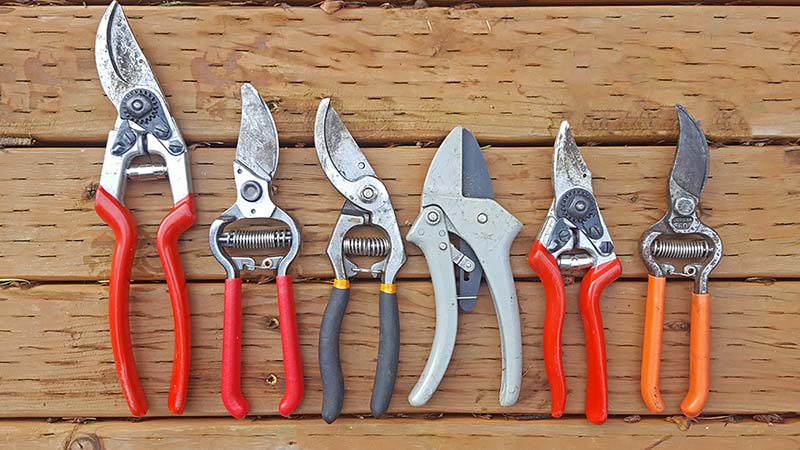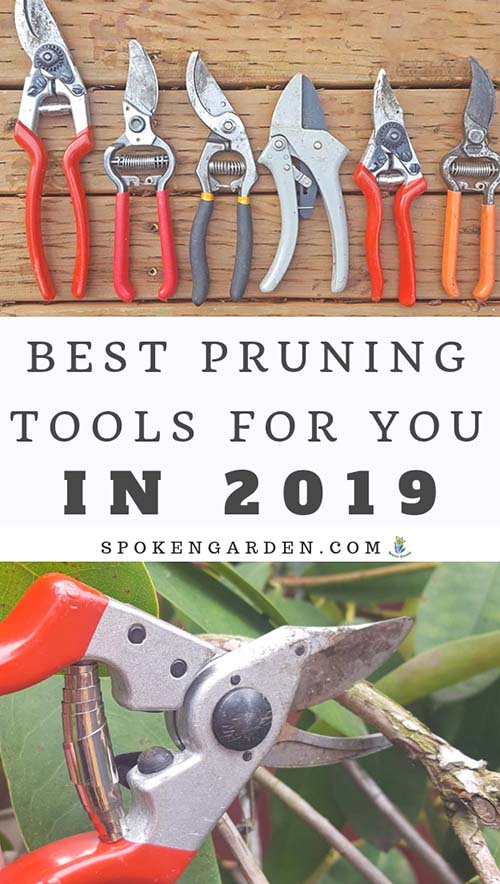Learn about the seven best pruning tools you should own, tips for correct tool use, and our favorite tools we recommend.
Contrary to popular belief, you don’t need to hire a professional to prune your plants and trees.
In fact, it’s possible to learn the basics of pruning and do it yourself but only if you have the correct pruning tools!
Knowing which type of pruning tool to use, like pruning shears vs. loppers vs. a pruning saw, and when to use each one can be the difference between healthy plants vs. dead ones.
We’re here to not only teach you about these 7 tools but help you invest in our picks for the BEST pruning tools for 2019.
We’ve been where you are before having insufficient tools and we want to help you AVOID that mistake.
Why? Because your plants are depending on you!
As you will learn, making these small investments in the proper tools will pay off for years to come!
Heck, it’ll actually save you money in the long run!
Read our Best Pruning Tools review to learn the following:
- The 7 pruning tools you need to use in 2019.
- Tips for how to best use each tool.
- Our time-tested recommendations plus direct links to buy each tool now.
Our recommendations below will highlight the best tools you should be using to freshen up your yard!
Alright, let’s get started! Your plants are depending on you.
In a hurry and want to read it later? Pin in here!
Best Pruning Tools
This year, we’re showcasing a mix of both hand and power pruning tools that we’ll be using for all our pruning tasks.
Whenever possible, we always try to promote environmentally-friendly or efficient tools, such as hand or electric-powered. However, sometimes you just can’t get around the massive strength of a gas-powered chainsaw.
By the way, we firmly believe in honest reviews and have not recommended any tools that we do not or have not personally used.
Whether in our own yard, private clients, or our previous landscaping business, these tools have proven indispensable over the years.
1) Pruning Shears
Pruning shears or hand pruners are defined as a hand-held pruning tool used to cut away smaller branches or stems with more precision and finesse.
Hand pruners work best when used on small stems up to 1-inch thick in diameter.
What are the Best Pruning Shears?
Our recommendation is The Corona ClassicCut Forged Bypass Pruning Shears for so many reasons! Mainly, the Corona ClassicCUT pruning shears are the best basic pruning shears you can buy because they are built with strength and dependability.
How Best To Use This Tool:
- These hand pruners work best when they are used on small stems up to 1 inch (but can be used for some larger stem sizes too at the user’s discretion).
- Can be used on most plants, including herbaceous and woody stems, along with harvesting cut flowers, deadheading, and removing dead or diseased wood.
- These pruners can also be used for cutting rubbing or crossing branches or stems and small-scale or precision shaping.
- Be sure to re-engage the thumb lock so no unwanted scrapes or cuts happen to you or anyone else.
The Corona ClassicCut Forged Bypass Pruning Shears can be your go-to tool for pruning.
Features:
- Good for tight spaces
- Self-sharpening
- Self-cleaning
- Made of forged steel (which is the best material for pruners!)
Benefits:
- These hand pruners are built with strength and dependability
- Can be used on deciduous trees, plants, flowers, shrubs, cutting wire, pretty much anything you can think of
- Ergonomically-shaped
Recommended Resources:
Sign up for our FREE 7-day Smart Pruning Basics email course.
Learn smart pruning principles and graduate past newbie status in just 7 days. Gain access to this FREE, 7-day email course and Begin Your Pruning Journey today.
2) Loppers
Loppers are best used for larger stems or branches over 1-inch thick that need more cutting leverage. This tool can be used for some finer cuts too.
In general, loppers are used for stems over 1-inch up to 2 or 2 1/2 inches in diameter.
What are the Best Loppers?
Our recommendation is the Fiskar’s 28-inch Bypass Loppers because, after 20+ years of use in many different situations, these loppers are the most dependable!
How Best To Use This Tool:
- These loppers work best for stems of any size between ½ an inch to 1.5 inches, in general.
- Power or Compound-loppers can also be used on oversized, larger limbs up to 2 1/2 inches.
- Can be used on most plants with woody or herbaceous stems to remove dead or diseased wood, rubbing or crossing branches or stems, and smaller scale or precision shaping.
Features:
- Constructed with two forged-steel pieces, instead of many like other models
- Rust-resistant and self-cleaning
- Has a shock-absorbing bumper stop to eliminate jarring forces from big cuts from affecting your body
- Non-slip comfortable grips for your hands
Benefits:
- Really powerful.
- Easy on your back and shoulders due to their long reach and lighter weight.
- Can be used on deciduous trees, plants, flowers, shrubs.
- Less maintenance due to few pieces compared to other makes and models.
Recommended Resources:
- Best Loppers For Your Pruning Needs
- DIY Garden Minute Ep. : Pruning Shears vs. Loppers
- Fiskars’ Demo Video
3) Pruning Hand Saw
A pruning hand saw is versatile, lightweight, and powerful enough for most pruning projects.
In general, pruning saws are used for cutting stems and limbs anywhere from 1.5 up to 3 inches.
What is the Best Hand Saw?
Our recommendation is the 7-inch PowerTooth Soft-Grip Folding Saw which we have been using for decades with little maintenance necessary.
How Best To Use This Tool:
- For smaller limbs with not a lot of weight on them.
- This hand saw is best for use on most plants in order to remove dead or diseased wood, rubbing or crossing branches, and smaller scale, precision shaping.
- If you have larger, thicker limbs to cut, you should use a chainsaw to save you time and a lot of effort.
Features:
- Ergonomic handle that has a soft grip.
- Hardened steel blade.
- High tooth count/inch blade.
- Compatible with a 10-inch blade (which we prefer).
Benefits:
- Great, affordable price for its capabilities
- Can be used in tight areas.
- Can cut a large range of sizes.
- It folds up so less chance of injury or accidents, and good for storing.
- Lightweight so it is easy on your shoulders and back when using.
Recommended Resources:
4) Hedge Shears
Hedge shears are a pruning tool that are GREAT for shaping plants with small-sized stems.
They are also a perfect tool for adding crisp, clean lines to shape your plants.
What is the Best Hedge Shears?
Our choice is The Fiskars Power Lever 8-inch Hedge Shears. They work the best and keep their blade cutting edge sharp with overuse. Even with little cleaning necessary!
How Best To Use This Tool:
- These hedge shears work best for plants needing shaping and stem sizes up to ¼ inch.
- Best to use on compact growing plants or plants that can take a “hedging”. General examples of these would be Boxwoods, Barberry, Laurel, Holly, Euonymus, some Dogwoods, Juniper, Arborvitae, and others.
- Any stems larger in size than this and you should first use hand pruners or loppers to clear the larger stems out.
- Since the cuts you should be making with hedge shears are not large, this tool is ideal for fine-tuning, delicate shaping of plants.
Features:
- Steel blade
- Self sharpens
- Corrosion-resistant
- Cushioned, comfortable hand grips
Benefits:
- Blades stay really sharp after lots of use.
- Lightweight so they won’t hurt your shoulders, back, or other muscles after lots of use.
- The grips are comfortable.
[maxbutton id=”78″]
Recommended Resources:
5) Husqvarna 455 20-inch Gas Chainsaw
A high-powered, gas chainsaw is a must-have for your arsenal of pruning tools!
They are perfect for ripping through larger pieces of wood and whole trees, if needed.
What is the Best Gas Chainsaw?
Our recommendation is the Husqvarna 455, 20 in. Gas Chainsaw because it just keeps cutting! Serious cutting power and a powerful engine make this tool more useful for precision cuts than you might think, with many holding positions, lighter weight than most of the competition, and easily serviceable.
How Best To Use This Tool:
- Mainly for quick cutting of branches and trees with diameters anywhere from 1 1/2 inches up to 12 inches, but be sure to read the manufacturers manual. Sean has been known to push his equipment past the recommended specs to get the job done, and this tool is tough.
- Best to use on small, medium or large trees and shrubs for thinning or complete removal from the landscape.
- Also use this chainsaw to remove dead or diseased wood, rubbing or crossing branches or stems, and larger scale tree scaffold shaping.
- It should not be used for cutting branches smaller than 1 1/2 inches or you run the risk to the chain coming off the bar, which can potentially damage your chainsaw and be very dangerous if the chain breaks and goes flying through the air.
- Keep chainsaw in front of you and out/away from your body at all times (goes without saying, but we felt we needed to mention it).
- Be sure to mix your regular gas with oil additive or you will burn up the motor FAST and follow the recommended mixing instructions.
Features:
- Gas-powered
- 11.2 lbs in weight
- 20-inch chainsaw bar length
- Air injection system results in fewer air filter cleanings and improved life overall
Benefits:
- This saw starts up quickly with minimal effort required (which we like)
- Chainsaw is high powered and heavy duty
- Saw will run a long time with good maintenance
- Can cut large and small limbs.
[maxbutton id=”82″]
Recommended Resources:
6) Sun Joe Electric Telescoping Pole Chain Saw
You know all those limbs and branches above your head that you just can’t quite reach with your new loppers? That’s where this amazing tool comes to the rescue!
This is the ideal pruning tool for all those stubborn, hard to reach places.
What is the Best Tool for Trimming Trees?
The pole chainsaw we love and recommend is the SunJoe 7-Amp Electric Telescoping Pole Chain Saw. Not only will it extend to a max of 15 feet, but it’ll also cut thinner logs as well.
This pruning tool has been a lifesaver many times when a chainsaw and a ladder is just not safe enough or the branches are out of our reach.
How Best To Use This Tool:
- Very similar to using the chainsaw above, except used for smaller diameter limbs higher in a tree’s canopy or needing a further reach.
- Best to use on trees and shrubs for lower branch cutting to thin the canopy and also for raising plant canopy off the ground.
- Can be used to remove dead or diseased wood, rubbing or crossing branches, and larger scale shaping.
- Don’t twist the saw or pole when cutting and don’t change your physical position when cutting. If you need to change positions or strengthen your footing, STOP cutting, and then change your cutting position or footing.
- An easy way to use this tool and cut down on fatigue is to keep the handle and trigger steady in one position keeping it close to your core. Another way is to keep it as close to your hip or lower ribs as possible. Then only move back the pole portion guiding it with your other hand.
- This tool makes it easy to switch hands later on so you can still keep cutting, but not overuse one arm over the other.
Features:
- Electric-powered, so less cost to purchase and to operate.
- Extends from 8.7 ft to 15 ft in length!
- 7 amp motor
- Cuts branches up to 7.5 inches thick
- 7 lbs. in weight
Benefits:
- Really great option for the price offered and the power available.
- This saw can cut above your head while you stay safe on the ground. No ladders needed!
- The saw can extend up to 15 ft for all your really hard to reach areas. We love this feature.
- It has an auto-oiler to keep it oiled up while in use.
- Pretty lightweight overall.
Recommended Resources:
7) Sun Joe Multi-Angle Telescoping Convertible Electric Pole Hedge Trimmer
The final pruning tool on our BEST of 2019 list is a power hedge trimmer. We featured hand-held hedge shears above because we feel you need to have access to both tools.
Power hedge trimmers are a great pruning tool because you can shape and shear many different plants with precision in a short about of time.
This tool makes it a lot easier on your wrists, elbows, shoulders, and back.
What is the Best Electric Pole Hedge Trimmer?
We highly recommend the Sun Joe Convertible Pole Hedge Trimmer for your pruning arsenal because it is powerful, it’s convertible, and it extends to a longer length when needed. This tool packs power, durability, portability, and the Sun Joe promise of a full 2-year worry-free warranty.
The manual hedge shears work great for shaping one or two small to medium sized plants, but with larger pruning projects, you can’t beat the ease, precision, and dependability of a Sun Joe Hedge Trimmer. Especially since it can be both a handheld trimmer and also be converted into a pole hedge trimmer!
How Best To Use This Tool:
- This trimmer can be used either with or without the pole and is only good for cutting up to 1/4 inch diameter stems cleanly.
- Best for shaping plants and creating crisp edges.
- For use on compact growing plants or plants that can take a “hedging”. General examples of these would be Boxwoods, Barberry, Laurel, Holly, Euonymus, some Dogwoods, Juniper, Arborvitae, and others.
- Similar to the pole chainsaw, this tool needs to be kept as close to your center or core as possible for good body mechanics.
Features:
- Electric
- Rust-resistant steel blades
- 4.5 amp motor
- Extends up to 13 ft.
- Multi-angle pivoting head
- Weighs less than 10 lbs.
Benefits:
- It converts from a hand-held trimmer to an extendable pole hedge trimmer! Really useful feature!
- Really great for the price and the power available.
- Works really well on all types of evergreen shrubs, bushes, and hedges.
- You can stay safely on the ground while extending the hedge trimmer with no need for a ladder.
- It works really well in tight spaces that you just can’t reach with your hand tools.
Recommended Resources:
How Do You Sterilize Pruning Tools?
Keeping your pruning tools sterile or even just clean is a big deal. If you don’t clean your tools after pruning each plant, you can spread different disease to other plants in yours and others gardens. If you know a plant has a disease and needs pruning, you can sterilize your tools after each cut or use so you don’t spread the disease around the plant.
To sterilize your tools, a simple solution to make is 1-part Bleach/Hydrochloric-Acid to 10-parts water. This will give you a 10% solution of cleaning solution to dip/wipe/scrub your pruning tools with. A shallow, wide bucket or bowl will work for your pruning shears, loppers, hand saws, and other smaller hand tools. For larger tools like pole-saws, chainsaws, and power hedge trimmers you can dunk into a 5-gallon bucket or apply to each tool by a rag/towel or even in a spray bottle.
Make sure to wipe each tool off after cleaning so it is dry and ready for its next use or for storage.
Other Recommended Pruning Tools
Below we want to recommend three additional tools to assist you in all your pruning clean up efforts.
These three tools are indispensable to us with not only cleaning up our large yard but spreading mulch, raking leaves, spreading gravel as well as tons of other garden maintenance tasks.
We hope these suggestions are helpful.
1) Fan or Leaf Rake
This rake works well for gathering and piling up any loose small stems or leaves for pickup and disposal.
Our choice is This 22.5 inch, 22-tine Metal Leaf Rake because this rake is strong and durable after years of use and quite honestly, the bright, red color makes it really easy to spot across the yard so you don’t lose it easy in a debris pile or the back of a truck!
How Best To Use This Tool:
- Great for raking over different surfaces to gather smaller and finer debris pieces. Don’t try to use for larger branches or rock as overuse of the rake, pressing too hard or trying to move too heavy of material as the tines will bend or break.
- When all done cleaning up in a garden bed over mulch or bark, turn the rake upside down so the tines are turned up and place on the mulch pushing and pulling back and forth to smooth out uneven mulch and chip areas.
[maxbutton id=”79″]
2) Bow or Hard Rake
This tool is really beneficial for your pruning jobs to help collect the medium to larger pieces of pruned debris.
Our choice is Bully Tools 12-Gauge,16-Inch Bow Rake because it is lightweight, but has a super strong handle. Also, this rake is long-lasting even in the cold and freezing temperatures. This is a perfect addition to your needed winter pruning tools, but is also useful year round in the garden!
How Best To Use This Tool:
- This hard rake works well for raking stems and other debris out of gravel and other areas after pruning.
- Also, this rake performs well moving larger debris into piles that your fan rake can’t, especially if your material is too heavy, such as larger limbs and other heavier materials.
3) Pitch Fork
This tool is GREAT because it helps speed up the clean-up portion of your pruning project.
A pitch fork helps you move the cut debris as you clean while saving your back from repetitive bending or stooping.
Our choice is the 5-Tine, 50-inch-handled Manure Fork by Truper because it is sturdy and lightweight.
How Best To Use This Tool:
- These wood handles are easy to grip so you get leverage when picking up debris.
- Don’t overload the fork or pick up too much at a time as it will be unbalanced and hard to control.
Best Pruning Tools Conclusion
As you can see above, choosing the correct pruning tool for that pruning job can make your life so much easier.
For all the different types of plants in your yard, our suggested pruning tools above will help you tackle your pruning projects safely and effortlessly.
We mixed up our list with a blend of hand tools, electric-powered tools, and one gas-powered tool. We also suggested three other tools that we use in our yard for all types of clean up projects.
By investing now in tools you’ll have for many years to come, you can save money by completing your pruning jobs throughout this year and many more to come.
No professionals necessary.
Additional Pruning Resources:
- How to Best Prune Your Garden This Winter
- Ep. 9: Fall Pruning Do’s and Don’ts
- DIY Garden Minute ep. 2: Pruning vs. Dead-Heading Revealed!
Thanks for reading and we hope this pruning tools list for 2019 will help set you up for success!
In addition, we have tons of pruning resources available to teach you how and when to prune. Also, stay tuned for our upcoming Pruning ebook launching soon!
See you in the garden!
~ Sean and Allison
P.S. Find us on Pinterest, Twitter, Facebook, and Instagram so you don’t miss a thing!
P.P.S. Check out our Resource Library page for FREE printable freebies in our Resource Library!
Spokengarden.com is a participant in the Amazon Services LLC Associates Program, an affiliate advertising program designed to provide a means for sites to earn advertising fees by advertising and linking to Amazon.com






